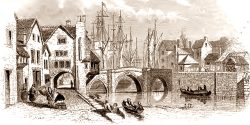Penel Orlieu Medieval to ?1900?

The White Horse Inn first appears in the records, it seems, in 1754 when we learn that the landlord was a Nicholas Briggs (David Williams, Bridgwater Inns Past and Present, p.60). The name of this Inn refers to the White Horse of the House of Hanover, kings of Great Britain from King George I, and is an expression of loyalty to them and opposed to Jacobitism and the deposed Stuart kings. Given the various Jacobite rebellions in the first half of the eighteenth century, this was a fairly firm political statement.
In the early nineteenth century the White Horse was a coaching stop for ‘Granfield’s Waggon’ which ran from Bath to Minehead (Powell Later Days, p.145). The large portal (which has four doors) in the other picture would have allowed horses and smaller coaches to be bought to a yard at the back of the building.

The White Horse was still functioning as an Inn up to around 1888, when it is mentioned among the property of Starkey, Knight & Ford brewery (whose logo, coincidentally, was also a White Horse) (Somerset Heritage Centre A/BUG/1/26/3). Sometime after this it was turned into a shop ‘Always’s White Horse Stores’ (David Williams, Bridgwater Inns Past and Present, p.60).
This picture above was taken between 1869 and 1872, which can be dated from the sign of the adjoining building, the Duke of Wellington (now the Blake Arms), as that was when Coles was landlord there (David Williams, Bridgwater Inns Past and Present, p.60).

Two once separate plots have been combined into the Inn premises, the further one being, it seems, later than the nearer. The further building appears to have a crude Flemish bond to the brickwork. Oddly, two wooden beam ends can be seen poking out of the brickwork on the gable, which might imply that the brick shell of the building conceals an earlier wooden core.

The nearer building looks as though it was originally intended to take a thatch roof, rather than tile as it has here. The nearest window on the ground floor does not match the fine moulding of the other three, suggesting that this may have been the original door way into the property.


It is not clear when the buildings were demolished in favour of the present buildings. They were certainly gone by 1900, when postcard images of Penel Orlieu show the new buildings. That the older building in the picture above seems to be in a poor state of repair, with what seem to be broken windows, we might assume that they were pulled down not long after this picture was taken.

Although this photograph can be dated to 1869 and 1872, it appears on a postcard with the postmark of 18 May 1905. It was sent to Miss Ada Fisher of 17 Dampiet Steet, Bridgwater. The message reads: ‘this is an old historical Inn which I though you may like to match the old Lamb from which I saw in your postcard album. Yours ever, Dick’. The front reads ‘The Old White Horse Cattle Market’.

